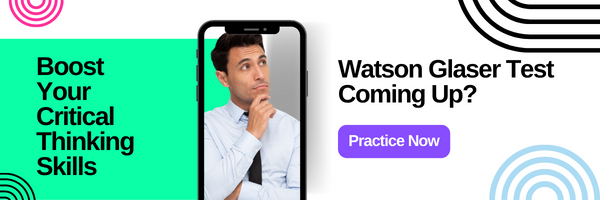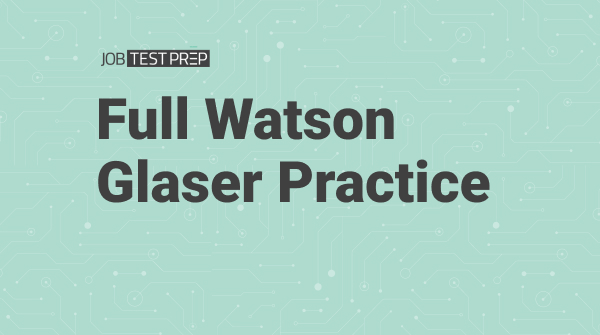What Are the 5 Sections of a Watson Glaser Test?
The test is split into 5 sections designed to assess how applicants can recognise assumptions, evaluate arguments and draw conclusions from a piece of text.
The test usually takes 30-50 minutes and you are able to go back and forward between questions and sections as you please.
With the right technique and familiarity, it is often possible to complete the test in a shorter amount of time.
Arguments Section
The arguments section gives a statement, in the form of a question with an argument. You, as the applicant, must decide whether the argument is a strong or a weak one.
It is easy to misinterpret these arguments as either strong or weak, if you personally agree or disagree with them.
A strong argument will address the initial statement in some form: this shows that the argument is directly related to the statement and will be relevant.
A strong argument will also provide a clear reason for its stance, that argues the original statement (not a similar statement, as this would be weak). If the argument does not fulfil this criteria then it can be considered weak.
Common mistakes that weak arguments make are: arguing separate points not directly related to the statement; not providing an advantage/disadvantage of the statement’s proposition; not stating links between cause and effect; merely giving a fact without relating it to the statement.
Assumptions Section
The assumptions section gives another short statement and an assumption. The task is to identify whether the statement has made this assumption.
An easy way to tell whether the assumption has been made or not is to see if the contrary can be true in the statement.
For example, our statement is “melons and bananas differ in many ways. For starters, all bananas are yellow”, and our assumption is that “melons cannot be yellow”. This assumption has not been made, as only some melons being yellow is a possibility in the statement, because only some melons need not be yellow for the statement to remain true.
Deduction Section
The deduction section gives a statement and a separate conclusion; it must be decided whether the conclusion follows from the statement.
Conclusions will relate to the statement, but can have a trigger word that makes it subtly different. Words like ‘some’, or ‘all’ in either the statement or conclusion can give away the answer.
If the statement says, “some of A enjoyed B” but the conclusion is “all of A enjoy B” it is different enough to not follow, as we know that some of A did not enjoy B.
Keeping an eye out for these points makes it easier to have a more certain answer. A similar trick is to give a statistic in two different forms: 20% and 1/5. These are identical values and can be misinterpreted as two different statistics in the heat of the moment, meaning the applicant believes the conclusion does not follow when it did.
Sometimes it is also easier to eliminate nouns and treat the statement as algebra. Take these two statements:
- All the employees must have a level 2 qualification to be a trainer
- All trainers are required to pass a personality review
This becomes:
- A must have B to = C
- C must have D
If our conclusion was “all employees with a level 2 qualification can be a trainer”, simply reading the first line could cause us to miss valuable data.
Always read the full statement. The ‘wordiness’ can also make it harder to process. But in algebra, we can see that while A might have B, it also needs D to equal C, so just having B is not sufficient to be C and the conclusion doesn’t follow.
Another section, with a paragraph rather than a statement, is essentially identical to this and can be treated as the same.
Inference Section
The inference section is a more complicated true/false task. In this section, the text is longer and can be skimmed for the information we are looking for alone.
True statements must be written at some point in the text to prove they are true; avoid clicking true because you know the fact to be true yourself.
‘Probably true’ statements are those that can be inferred from the text to be true, but are not directly written in it. They are more likely to be true given what the text has said.
These statements will often not give specifics and will use words like ‘such as’ and ‘suggest’.
As a loose rule, if you can argue it to be true or false equally based on the text, then it is considered as ‘more data needed’. False and probably false are simply the opposite of true and probably true.
It is wise to save the most time for this section as skipping parts of the text can make us miss a sentence that is key, It is not uncommon for the text to have two sentences (perhaps at the start and at the end, just to be a pain) that both are needed to prove the statement as true or false.
By practising the Watson Glaser Test (for example with Job Test Prep’s practice tests), it can be easier to pick up on common tricks that are used, as they tend to be recycled each time. Familiarity is your strongest ally when passing the test.
Interpretation Section
The interpretation section of the Watson Glaser test is often considered one of the most challenging for applicants, as it requires them to understand the text and draw logical conclusions from it.
This section of the test will often include a longer piece of text, and the questions will ask the candidate to draw an inference from the text.
To answer questions in the interpretation section, it is important to read the text carefully and take note of any key phrases. As the text can often be lengthy, it is important to skim-read it to identify any relevant information.
The test will require the applicant to identify facts and inferences from the text, and it is important to distinguish between the two. A fact is something that can be proven true from the text, whereas an inference is something that can be concluded from the text but cannot be proven to be true.
When answering questions in this section, it can be beneficial to highlight key words in the text. This can help to quickly identify any relevant information in the text when answering questions.
It is also important to consider any alternative interpretations of the text and think critically about the question.
To achieve a high score in this section, consider any alternative interpretations of the text and think critically about the question. This can help you identify any relevant information in the text and draw logical conclusions from it.
How Do You Prepare For A Watson Glaser Test?
Preparing for the Watson Glaser Test is key to achieving success. It’s important to familiarise yourself with the test format and hone your critical thinking skills. Here are some expert tips and strategies to help you prepare.
Understand the Test Format
You must understand the format of each of the 5 sections, as well as the types of questions you may encounter. Understanding the format can help you better manage your time and effectively prepare for the test.
You should also familiarise yourself with the different types of questions and answer formats. This will give you a better understanding of the test structure, the types of questions, and the best strategies for tackling each type of question.
Practice with Watson Glaser Practice Tests
Practising with Watson Glaser practice tests is one of the best ways to prepare. Practice tests are designed to emulate the structure and format of the actual test, as well as provide you with sample questions to help you familiarise yourself with the types of questions you may encounter.
You can try our free Watson Glaser practice test here, or for more practice, Job Test Prep’s Watson Glaser tests.
Distinguish Between Facts and Inferences
The Watson Glaser Test requires you to identify facts and inferences from the text. A fact is something that can be proven true from the text, whereas an inference is something that can be concluded from the text but cannot be proven to be true.
Develop Your Critical Thinking Skills
The Watson Glaser test is designed to assess your critical thinking skills, which includes evaluating sources plus inductive and deductive reasoning.
To practice evaluating sources, you can read articles or opinion pieces and try to assess the reliability of the arguments by considering the source’s credentials, the evidence they are presenting and whether the information may be biased.
Deductive reasoning involves using general principles to draw specific conclusions. Logic puzzles or riddles are a great way to practice these skills.
Inductive reasoning involves using specific observations to draw general conclusions. To practice this skill, look at data sets from articles or journals. Try to identify any patterns in the data and think about any conclusions you can draw or any predictions you could make based on these results.
Use Resources
There are many resources available to help you prepare for the Watson Glaser Test. Our detailed guide on the Watson Glaser test is a good starting point for understanding the test structure and types of questions you will get asked.
Resources such as Job Test Prep’s practice tests are designed to give you a better understanding of the test format and hone your critical thinking skills.
By following these tips and strategies, you can better prepare yourself for the Watson Glaser Test.


